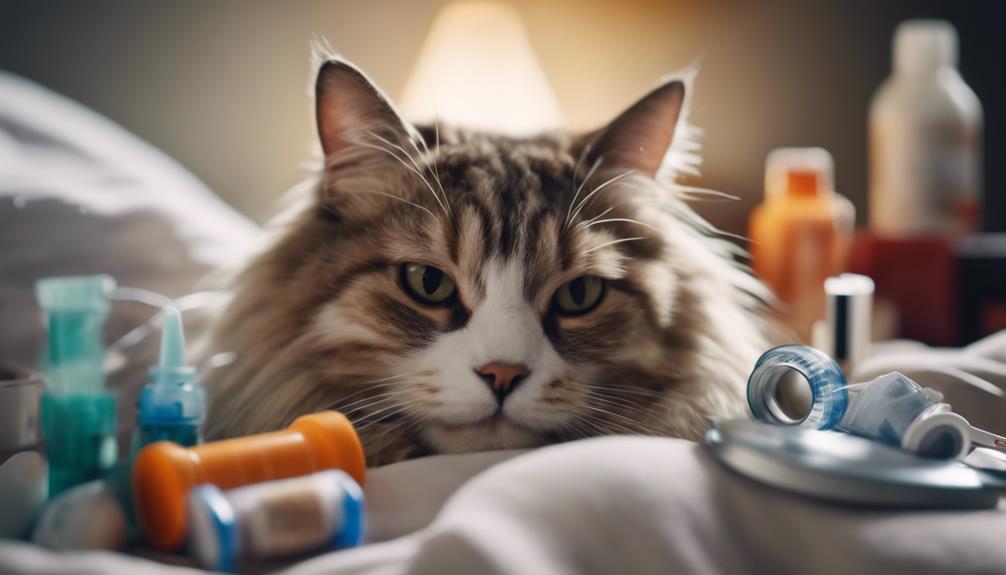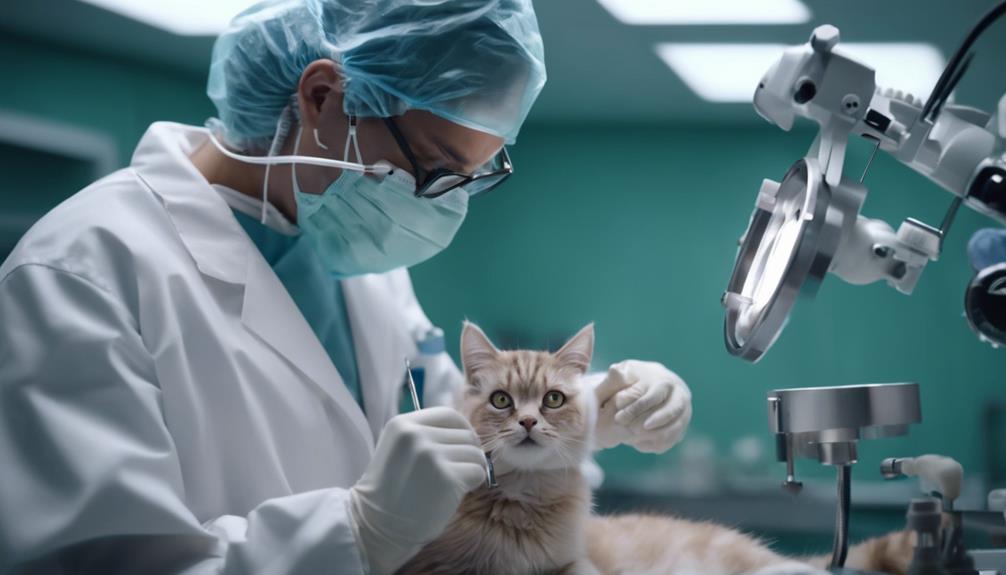Pet owners often grapple with the decision of whether to neuter their cats, a procedure that carries substantial implications for the well-being of both individual pets and the broader feline population. Understanding the intricacies of cat neutering, from its behavioral benefits to the impact on community welfare, is crucial in making informed decisions.
As we delve into the comprehensive guide on how to neuter a cat and the compelling reasons to consider this veterinary procedure, we unravel the layers of significance and implications that extend far beyond the operating table.
Key Takeaways
- Neutering plays a vital role in controlling the feline population and improves overall cat well-being.
- Neutering prevents unwanted litters, reduces homeless cats, and leads to behavioral improvements.
- Neutering has significant health benefits, reduces disease risks, and promotes safer pet ownership.
- Neutering helps control the cat population, enhances community dynamics, and promotes healthier interactions.
Neutering: Definition and Purpose
What is the significance of neutering in cats and how does it serve its purpose in animal welfare?
Neutering plays a vital role in controlling the feline population and improving the overall well-being of cats. By preventing unwanted litters, neutering helps reduce the number of homeless and euthanized cats. Additionally, this procedure can lead to behavioral improvements, such as decreased aggression and territorial marking.
Neutering not only benefits the individual cat but also contributes to a healthier and more harmonious cat community. Responsible pet owners play a crucial role in ensuring that their cats are neutered, thus promoting animal welfare and helping manage the feline population in a humane way.
Behavioral Benefits of Neutering
How do behavioral patterns in cats typically change after undergoing the neutering procedure? Neutering can have significant behavioral benefits for cats, leading to a more harmonious relationship between feline companions and their owners.
Here are three ways in which neutering can positively impact a cat's behavior:
- Decreased Aggression: Neutering can reduce aggressive tendencies in male cats, making them less likely to engage in fights with other cats or exhibit territorial behavior.
- Diminished Roaming: Neutered cats are less likely to roam far from home in search of a mate, decreasing the risk of getting lost or injured.
- Reduced Marking: Neutering often decreases or eliminates urine spraying, a common behavior in unneutered cats seeking to mark their territory.
Ideal Age for Neutering Cats

The optimal age for neutering cats is a critical consideration in ensuring their long-term health and behavioral well-being. Most veterinarians recommend neutering kittens between 5 and 8 months of age. This timing is ideal as it helps prevent unwanted behaviors like spraying and marking territory before they start.
Neutering at this age also helps reduce the risks of certain health issues and promotes a longer and healthier life for your feline companion. While early neutering at a few weeks old is possible, it may lead to potential health concerns. Therefore, decisions regarding the best age for neutering should be based on individual cat health, behavior, and the advice of a trusted veterinarian.
Health Considerations for Neutering
When considering the optimal age for neutering cats, it is essential to also address the health considerations associated with this surgical procedure. Neutering not only helps control the pet population but also has significant health benefits for the individual cat.
Here are three key health considerations to keep in mind:
- Reduced Risk of Certain Diseases: Neutering can lower the risk of reproductive cancers, such as testicular cancer in males and mammary cancer in females.
- Behavioral Improvements: Neutering can reduce aggressive behaviors, urine spraying, and roaming tendencies, leading to a safer and more predictable pet.
- Prevention of Reproductive Issues: By removing the reproductive organs, issues like uterine infections and testicular tumors can be prevented, promoting a longer and healthier life for your cat.
Neutering Costs and Recovery

Neutering procedures for cats involve both cost considerations and postoperative recovery processes that are essential aspects of responsible pet ownership. The cost of neutering can vary depending on factors such as the type of anesthesia used and any additional services required. Typically, the cost ranges from $200 to $400, with low-cost programs available for those seeking more affordable options.
In terms of recovery, kittens tend to bounce back quickly and resume their normal activities shortly after surgery. However, adult cats may require more rest and monitoring post-surgery to ensure a smooth recovery. Properly managing both the cost and recovery process is vital in ensuring the well-being of your feline companion after undergoing the neutering procedure.
Neutering: Impact on Cat Community
Neutering cats plays a crucial role in fostering a healthy and balanced feline community.
- Population Control: Neutering helps reduce the number of unwanted kittens born, ultimately decreasing the strain on animal shelters and resources.
- Promotes Healthier Interactions: Neutered cats are less likely to engage in aggressive behaviors such as fighting, resulting in a more peaceful coexistence within the cat community.
- Enhances Well-being: By preventing certain health issues and undesirable behaviors, neutering contributes to a happier and harmonious environment for all cats involved.
Together, these factors highlight the significant positive impact that neutering can have on the overall well-being and dynamics of the cat community.
Neutering: Responsible Pet Ownership

Ensuring the well-being of companion animals through proactive reproductive management is a hallmark of responsible pet ownership. Neutering plays a crucial role in this commitment by controlling the pet population and promoting a healthier cat community.
By opting for neutering, pet owners actively contribute to reducing the number of homeless and abandoned cats, thus alleviating the burden on animal shelters and rescue organizations. Additionally, neutering can help prevent certain health issues and undesirable behaviors in cats, leading to a happier and more harmonious coexistence between pets and their human companions.
Ultimately, choosing to neuter your cat is a responsible decision that not only benefits your furry friend but also demonstrates your dedication to being a responsible and caring pet owner.
Neutering: Veterinary Procedure Overview
By understanding the intricacies of the neutering process from a veterinary perspective, pet owners can ensure the well-being and long-term health of their feline companions.
- Surgical Expertise: Veterinarians perform neutering surgeries with precision, skill, and care to minimize risks and complications.
- Anesthesia Management: Proper administration and monitoring of anesthesia ensure the cat's comfort and safety throughout the procedure.
- Post-Operative Care: Veterinarians provide detailed instructions for post-operative care, including monitoring for any signs of infection or complications, to promote a smooth recovery process.
These aspects highlight the importance of entrusting your cat's neutering procedure to a qualified veterinary professional.
Neutering: Common Myths Debunked

Dispelling misconceptions surrounding the neutering process is crucial for pet owners seeking accurate information about this common procedure. One common myth is that neutering will make cats lazy or fat. In reality, proper diet and exercise are the main factors affecting weight gain in cats, not neutering.
Another myth is that neutering will drastically change a cat's personality. While there may be some behavioral changes, like decreased aggression and roaming, neutering generally helps stabilize a cat's behavior rather than completely alter it.
Lastly, some believe that neutering is only necessary for male cats. However, spaying female cats is equally important for population control and health reasons. It's essential to separate fact from fiction when considering the decision to neuter your cat.
Frequently Asked Questions
Can a Cat Still Reproduce After Being Neutered?
Neutered cats cannot reproduce. This surgical procedure removes the reproductive organs, preventing mating and offspring. Neutering is a responsible choice for pet owners, offering benefits like behavior improvement, health advantages, and aiding in controlling cat overpopulation.
Are There Any Long-Term Health Risks Associated With Neutering a Cat?
Neutering a cat is generally safe and beneficial, with potential health risks being rare. Some studies suggest an increased risk of certain conditions like obesity or urinary issues, but the benefits of neutering often outweigh these minimal risks.
How Long Does It Take for a Cat to Fully Recover From the Neutering Surgery?
After neutering surgery, a cat typically takes around 7 to 10 days to fully recover. Kittens may resume normal activities sooner than adult cats, who might need more rest and monitoring post-operation. Professional guidance during recovery is advised.
Are There Any Behavioral Changes That May Occur in a Cat After Being Neutered?
After being neutered, cats may exhibit reduced aggression, spraying, and roaming tendencies. Neutering can positively impact behavior by curbing territorial marking and fighting instincts. It's a responsible choice for pet owners to consider for their cat's well-being.
Is There a Difference in the Neutering Procedure for Male and Female Cats?
Yes, there is a difference in the neutering procedure for male and female cats. Males undergo castration, which involves the removal of testicles, while females have an ovariohysterectomy, which removes the ovaries and uterus. Both procedures are commonly performed by veterinarians.
Conclusion
In conclusion, neutering plays a crucial role in promoting responsible pet ownership and contributing to the overall welfare of the feline community.
By understanding the behavioral, health, and cost considerations associated with this veterinary procedure, pet owners can make informed decisions that benefit their cats and the broader population.
Neutering helps to control cat overpopulation, prevent certain health issues, and promote a healthier and happier environment for cats.




